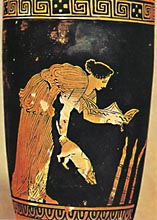The first day of the Thesmophoria
festival was known as Anodos. This was
probably owing to the fact that the procession of women
went over to the Thesmophoria area, which was on an
eminence. They took with them the paraphernalia of the
rite; food and drink; the sacrificial pig; and anything
else they would need for their sojourn there. The
sacrifice took place in the evening. In classical Athens,
there were two leaders of the women taking part in the
festival: they were called archusae.
The
Thesmophoria got its name from the noun thesmos -
'that which is set in place, put in a particular area'.
From the ancient sources we know that a woman would throw
a piglet and a clay model of a pig into a pit called a megaron,
as votive objects. She would also throw a model of a
snake and a male genital organ, made of dough, and a pine
branch. (Pits of this kind have been found at other
shrines of Demeter in the acnient world, but not at
Athens). The above objects may have deposited in the megaron
as much as three months or even a year before the
festival. |
 |



